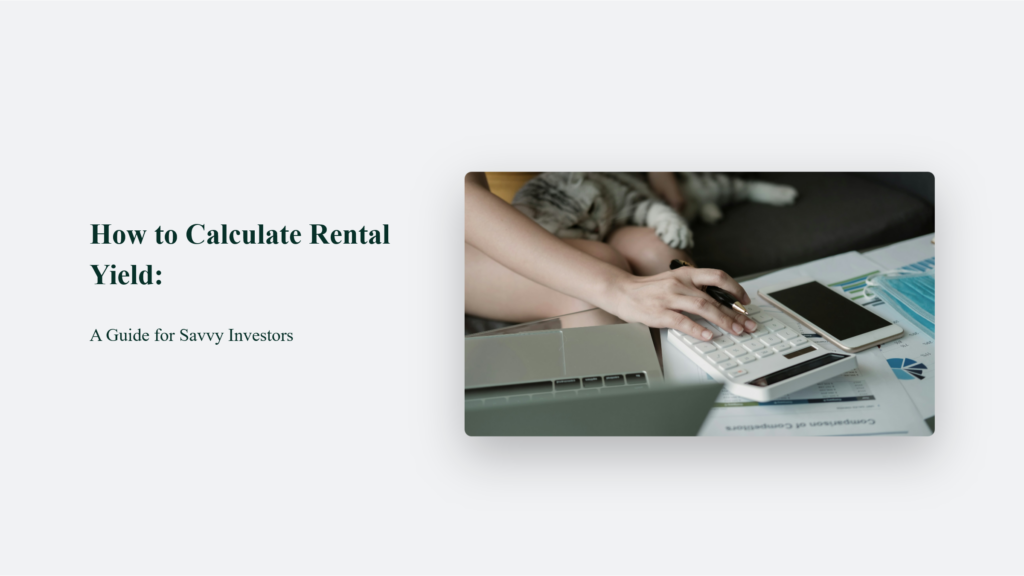Calculating a property’s rental yield is like checking the pulse of your investment. It’s an essential metric that shows how healthy your investment is in the real estate market. So, let’s find out how to calculate rental yield.

What is Rental Yield?
Rental yield is a critical financial metric used in the real estate sector, representing the annual rental income from a property as a percentage of its purchase price or current market value. This figure is essential for investors as it provides a clear picture of the potential return on their investment.
There are two types of rental yields: gross rental yield, calculated before expenses, and net rental yield, which factors in operating costs. Rental yield is a straightforward yet powerful tool that offers insight into the profitability of rental properties and guides investment decisions.
Gross vs. Net Rental Yield
- Gross Rental Yield: This is the simplest of the two, calculated by dividing the annual rental income by the property’s purchase price or value, then multiplying by 100.
- Net Rental Yield: This digs deeper by considering operating expenses. It’s calculated by subtracting annual expenses from the rental income, then dividing by the property value and multiplying by 100.
How to Calculate Rental Yield:
How to Calculate Gross Rental Yield: A Straightforward Affair
Calculating Gross Rental Yield is a straightforward process that involves just a few steps.
For example, George purchases a property for $600,000 and rents it out at $450 per week. To find the annual rental income, multiply the weekly rent by the number of weeks a year: $450 x 52 = $23,400.
Then, the gross rental yield is calculated by dividing this annual income by the property’s purchase price and multiplying it by 100.
So, for George’s property, the gross rental yield is ($23,400 / $600,000) x 100, which equals 3.9%. This percentage gives an initial insight into the investment’s profitability.
Unveiling the Net Rental Yield: The True Picture
Unveiling the Net Rental Yield: Calculating net rental yield provides a more realistic picture of investment returns by accounting for expenses.
In George’s example, his property generates an annual rental income of $23,400. After accounting for expenses totalling $4,920, the net rental yield is calculated as (($23,400 – $4,920) / $600,000) x 100, resulting in a yield of 3.1%.
Beyond the Numbers: Insights and Strategies for Maximizing Rental Yield
Improving Your Properties
If your rental yield isn’t meeting expectations, it’s a clear sign that you might need to revisit and refine your investment strategy. Here’s how you can potentially enhance your rental yield:
- Upgrades and Renovations: Small improvements can make a big difference. Upgrading appliances, refreshing the paint, or modernizing fixtures can increase the property’s appeal and allow for higher rental prices.
- Energy Efficiency: Investing in energy-efficient features can reduce operating costs, making your property more attractive to eco-conscious tenants and potentially justifying a higher rent.
- Amenity Additions: Adding amenities like high-speed internet, a security system, or a furnished option can increase the value of your rental property.
The Role of Tenant Screening
Tenant screening plays a crucial role in optimizing rental yield. By ensuring that you have reliable and long-term tenants, you can minimize vacancies and associated costs:
- Background Checks: Conduct thorough background checks to assess potential tenants’ reliability and financial stability.
- Credit Reports: Credit reports can give insight into a tenant’s financial history and ability to pay rent on time.
- References: Previous landlords can provide valuable insights into a tenant’s behaviour and reliability.
Regular Review: A Must for Investors
The real estate market is dynamic, so your investment strategies should be as well:
- Market Analysis: Regularly analyze the market to ensure your rent is competitive. Adjust according to market trends and demands.
- Expense Management: Review and manage your operating expenses regularly. Finding more cost-effective solutions for services and maintenance can improve your net yield.
Exploring HMOs (Houses in Multiple Occupations)
HMOs, where properties are rented by at least three tenants who form more than one household, can be a lucrative investment strategy:
- Higher Rental Income: With multiple tenants, HMOs often generate higher rental incomes than single-tenant properties.
- Diversification of Income Streams: Having multiple tenants can provide a safety net; if one tenant leaves, you still have income from others.
- Logistical Considerations: Managing an HMO can be more complex. It involves adhering to specific regulations, managing relationships between multiple tenants, and potentially more frequent maintenance issues.
Calculating and understanding rental yield is crucial for any real estate investor. It provides a snapshot of your current returns and helps you make informed decisions about future investments and property improvements. Remember, it’s not just about the numbers; it’s about how you interpret and act on them to ensure your investment remains healthy and profitable.
Frequently Asked Questions:
What Factors Affect Rental Yield?
Location, property condition, market demand, and operating expenses.
How Often Should I Review Rental Yield?
At least annually or whenever there are significant market changes.
Can Renovations Impact Rental Yield?
Absolutely. Improvements can justify higher rents and attract quality tenants.




